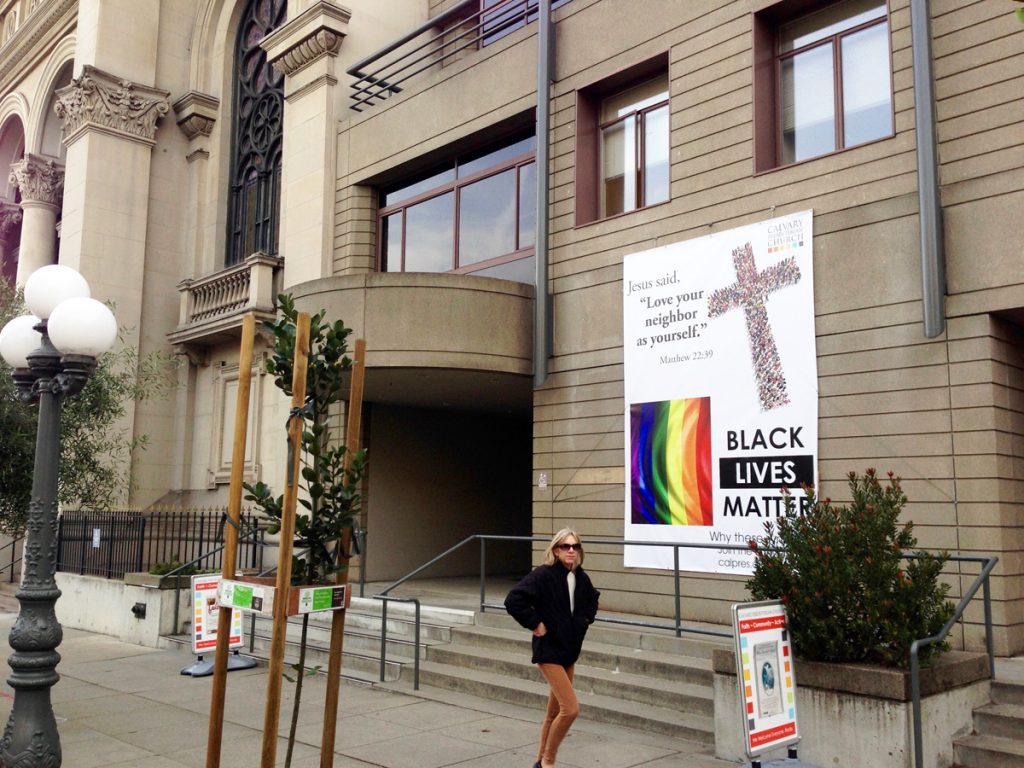FIRST PERSON | FRAN MORELAND JOHNS
It started out of frustration. A pastor at a mainline San Francisco church got tired of pulling together candlelight services after yet another black youth was killed. He wanted to do something positive to show support for the black friends he and many of his parishioners knew. So he hung a banner on the front of the church’s education building. Black Lives Matter, it proclaimed, the logo of a nascent movement.
This happened a few months ago at Calvary Presbyterian, the 164-year-old church at the corner of Fillmore and Jackson. Alongside the banner, minister John Weems hung a rainbow flag. He was also weary of attacks on the LGBTQ community, which incredibly still occur in San Francisco.
“Oh, that’s good,” I thought when I first saw them — admittedly after several weeks of walking by without noticing a thing. Although not much of a protest person, I had joined a group from Calvary and Grace Tabernacle Church in the Bayview some months earlier for a candlelight vigil. We paused at almost a dozen spots where black men and boys — and in one case a young woman — had died of gunshots. A young man walking with me casually remarked, “I got shot over there.” That experience drove home the sadness of knowing good people who live with gun violence every day, just across town, and opened my eyes to the Black Lives Matter movement.
Almost everyone I encountered at Calvary had the same response to the banners: “Oh, okay, that’s cool.”
But not everyone was pleased — as might be expected in any group of three or more, and Calvary’s membership currently hovers around 1,000. Protests mounted: “Black Lives Matter is too political! The church should not be involved in politics.” And “That Black Lives Matter banner disrespects the police.” Also “The Black Lives Matter movement has been hijacked by thugs.” And the argument only a Presbyterian might fully appreciate: “Proper process was not followed.”
So John Weems, supported all along by fellow pastors Joann Lee and Victor Floyd, returned to proper process: have meetings with leaders of the congregation, listen to everyone, gather data, study scripture, pray a lot, issue statements, then make an eventual decision.
As a current member of the Calvary Session — that’s Presbyterian for board of directors — I was caught up in the process, party to hundreds of emails, phone calls, conversations and meetings on the topic.
“You’re doing what churches ought to do — good for you,” said one of several neighborhood residents who had probably not entered a house of worship in years, but took the trouble to ring the bell, walk in and express support. Another neighbor, who identified herself as a Catholic, left a tearful voice mail message saying how appreciative she was, adding that she planned to urge her own church to become more pro-active. One woman who noticed the banners while riding by on a Muni bus said, “That’s for me,” and showed up at Calvary the next Sunday.
In all probability there were neighbors who disapproved of the banners. But interestingly, not one member of the outside community — including the captain of the local police precinct, who was fine with it all — stomped in to demand that the banner and flag be removed.
At several forums held at Calvary, church members and neighborhood visitors gave emotional testimony about their own suffering from racial bias, about why they strongly supported the banner and flag, or in some cases why the signs might cause them to go somewhere else to worship. But unlike some of the public debates of recent months, the conversations were unfailingly civil, respectful and polite.
Eventually, a Presbyterian decision was reached. The Session issued a statement, proper process was followed — and a new banner replaced the two signs. The new banner incorporates that “Love thy neighbor” business Jesus talked about, and an invitation to “Join the conversation.”
Both new and old Fillmore are included in that invitation. The conversation is ongoing, with visits from law enforcement officers, leaders in conflict resolution and programs on implicit bias and related topics extending into 2017.
Filed under: Body & Soul, First Person





